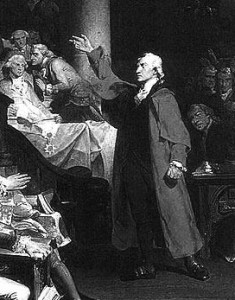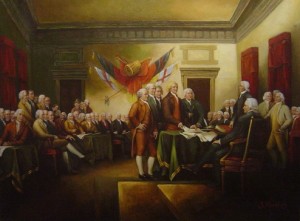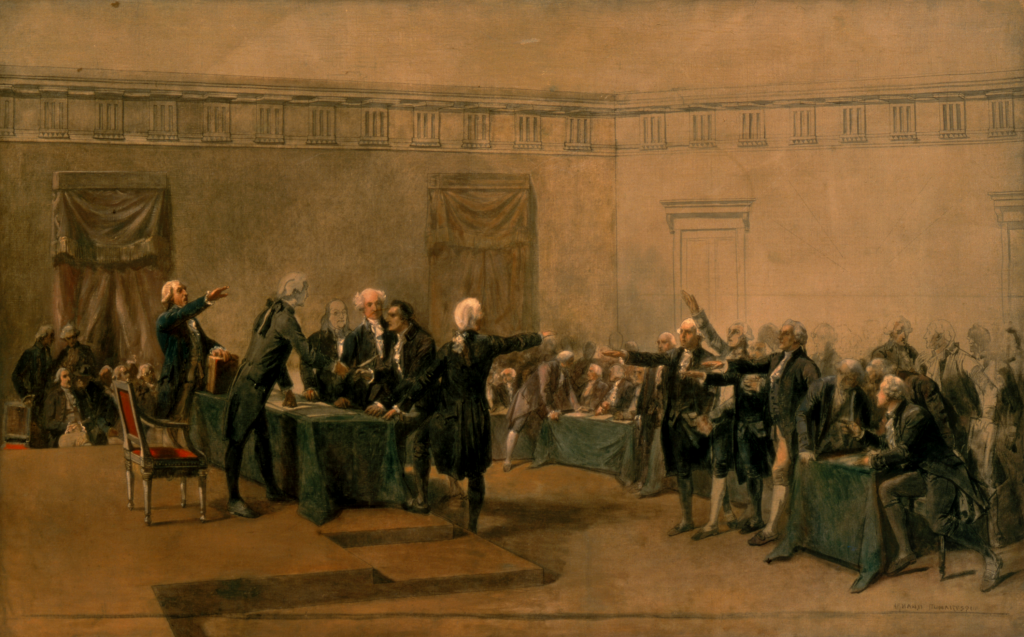 As I undertook my 4th of July week tradition of watching the second episode of the HBO Series John Adams starring Paul Giamatti where the Continental congress signs the Declaration for Independence, I thought for the first time since watching about Virginia, and specifically Richmond’s role in this.
As I undertook my 4th of July week tradition of watching the second episode of the HBO Series John Adams starring Paul Giamatti where the Continental congress signs the Declaration for Independence, I thought for the first time since watching about Virginia, and specifically Richmond’s role in this.
Richmond was not the capital of Virginia at the time; it was in Williamsburg, thus most of the official activity took place there rather than RVA.
Now, there were several factors that led Virginia to vote for independence from Britain. The Pistole Fee of 1752, the Stamp and Tea Acts, the Intolerable Acts, the dissolution of the Virginia House of Burgess, and finally, the seizure of the gunpowder stores of the Virginia Militia by Lord Dunmore, the Governor of Virginia.
These things were totally not cool.
The House of Burgesses, being dissolved, continued meeting illegally. One of the duties of this body was to give directions to the Virginia Delegation to the Continental Congress.
The Delegation to the first Continental Congress in 1774 consisted of: Richard Bland, Benjamin Harrison, Patrick Henry, Richard Henry Lee, Edmund Pendleton, Peyton Randolph, and George Washington.
In 1775, the Second Continental Congress then began, making known to the states the desires of the legislative bodies other states.
As time went on and the British became more suspicious, they started moving these meetings farther away from where British troops were stationed.
This is why the secondx meeting of this clandestine legislature took place in Richmond. The Second Virginia Convention was held, in St. John’s Episcople Church on Church Hill, in order to avoid the gaze of the British Imperial governor.
The delegates debated about how to deal with the afronts to the good folks of the colony of Virginia. The who’s who of Virginians were at this convention, including George Washington and Thomas Jefferson. Finally, according to a source written in 1816, Patrick Henry, the first governor of Virginia gave his famous impassioned speech:
“It is in vain, sir, to extenuate the matter. Gentlemen may cry, Peace, Peace – but there is no peace. The war is actually begun! The next gale that sweeps from the north will bring to our ears the clash of resounding arms! Our brethren are already in the field! Why stand we here idle? What is it that gentlemen wish? What would they have? Is life so dear, or peace so sweet, as to be purchased at the price of chains and slavery? Forbid it, Almighty God! I know not what course others may take; but as for me, give me liberty or give me death!”
This speech would swing the opinion of the delegates toward arming the militia of Virginia… a step to resisting British rule.
FYI: The speech was written down in 1816 by someone who was there and saw it, but for all we know, this speech may have never been made, but some things are nice to go on believing, right?
The third, fourth, and fifth conventions would take place in Williamsburg again,as the governor of Virginia, Lord Dunmoore, fled to the coast and his watchful eyes weren’t menacing the clandestine legislative bodies who undertook the basic business of the state government.
The fifth convention began on May 6, 1776 in Williamsburg. The convention declared independence from Britain and resulted in three actions: a call for a declaration of rights for Virginia, a call for establishment of a republican constitution, and a call for federal relations with whichever other colonies would align with them.
It also instructed its delegates to the Continental Congress in Philadelphia to declare independence.
It’s important the understand that Virginia was, by far, the richest of the colonies and that these men who were voting for independence were wealthy, landowning individuals and prominent citizens in this wealthy state that had a lot to lose should this war effort go south.
The Virginia delegation Consisted of George Wythe (attorney and mentor of Thomas Jefferson), Richard Henry Lee (Great Great Uncle of Gen. Robert E Lee), Thomas Jefferson, Benjamin Harrison, Thomas Nelson, Francis Lightfoot Lee, and Carter Braxton.
 Richard Henry Lee and the Virginia delegation were the first to put forth a resolution for independence and the delegates peacefully without hesitation agreed and one-by-one walked up to sign the Declaration of Independence. Like this John Trumbel painting…
Richard Henry Lee and the Virginia delegation were the first to put forth a resolution for independence and the delegates peacefully without hesitation agreed and one-by-one walked up to sign the Declaration of Independence. Like this John Trumbel painting…
NOT!
It was more like after a month chalk full of arguing, political wrangling, and backroom negotiations, the vote was finally unanimous (with New York abstaining) in favor of independence.
It looked more like this 1873 Armand Dumaresque painting:
Thus began the long and bloody birth of a new nation….
Happy Independence Day!

